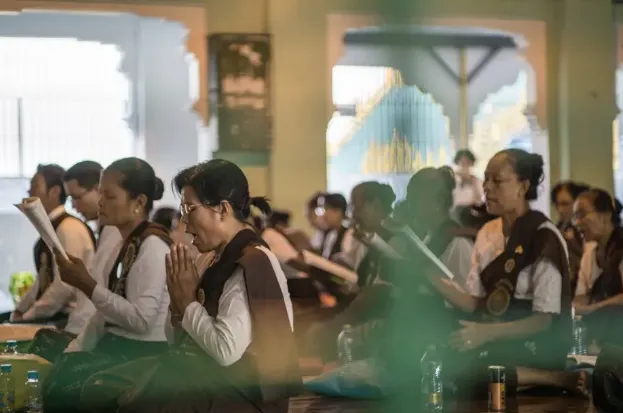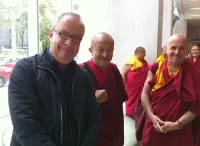Help Crestone Films bring
the wisdom traditions to global audiences.


Blog
Reviews

What Role Do Films Play in Spreading Buddhist Teachings?
The use of film as a medium to share and promote Buddhist teachings has grown significantly in recent years. With its unique ability to blend sound, visuals, and storytelling, film offers a compelling way to communicate the profound principles of Buddhism to a wider audience. This blog explores how films contribute to the dissemination of Buddhist teachings.

How Films Capture the Essence of Buddhism
Films have the unique ability to encapsulate the intricate principles of Buddhism through compelling narratives and vivid visuals. By portraying stories of historical figures and modern-day practitioners, films can depict the delicate balance between spiritual teachings and real-world challenges. This medium serves as a channel for illustrating Buddhist concepts in a way that written text alone may not fully capture. Take for example the film 'YANGSI: REINCARNATION IS JUST THE BEGINNING,' which masterfully presents the journey of a young Tibetan boy recognized as a reincarnate lama, guiding viewers through the complex themes of reincarnation and tradition Discover transformative Buddhist films that every enlightenment-seeker must see.
One of the fascinating aspects of Buddhist films is their ability to embody compassion, mindfulness, and wisdom, which are core tenets of Buddhist philosophy. These films often juxtapose human experiences with the guiding principles of Buddhism, allowing audiences to draw meaningful parallels to their own lives. For instance, ‘BODHISATTVA: JOURNEY OF THE 17th KARMAPA’ showcases the intersection of cultural tradition and personal growth through the lens of a young spiritual leader who embraces ancient wisdom as a beacon in his journey through the West NURTURING COMPASSION. This approach enables viewers not only to understand but to relate and apply these teachings in their day-to-day experiences.
The Power of Visual Storytelling in Buddhist Films
Visual storytelling in films provides an immersive experience that can deeply engage viewers in the teachings of Buddhism. By integrating peaceful imagery and thoughtful cinematography, films like ‘The Bloodless Valley’ present serene landscapes that mirror the tranquility promoted by Buddhist teachings. This use of striking yet calm visuals serves to reinforce the essence of mindfulness, inviting viewers to reflect on the peace attainable through Buddhist practices.
The evocative power of films like ‘EYE OF THE LAND’ amplifies the spiritual lessons inherent in Buddhist teachings. By chronicling the creation of the Tashi Gomang Stupa, this documentary highlights the communal dedication central to Buddhist architecture and the reflection of spiritual peace within a tangible structure EYE OF THE LAND. Such detailed visual storytelling not only illustrates Buddhist ideals but also encourages audiences to explore these values within their own lives.
Reaching Wider Audiences Through Cinema
Cinema’s global reach makes it an effective tool to disseminate Buddhist teachings beyond traditional geographic and cultural boundaries. Films like 'Walk With Me' introduce the serene world of Thich Nhat Hanh's monastic community to a worldwide audience, drawing people into the practical applications of mindfulness and the daily life of monks and nuns. Through the universal language of film, complex Buddhist teachings are made accessible to viewers regardless of their cultural backgrounds Best Documentaries About Buddhism: Enlightening Insights for Seekers.
Moreover, documentaries such as 'My Reincarnation' provide a rare glimpse into the lives of Tibetan Buddhist figures and the cultural nuances of their lives, thus fostering an appreciation and understanding of Buddhist practices globally. The intricate depictions of spiritual journeys documented in such films open the door to discussions about Buddhism’s relevance in contemporary life and serve as inspiring tales of faith, resilience, and personal transformation.
Films as a Modern-Day Sangha
In Buddhism, a ‘Sangha’ refers to a community of practitioners who inspire and support each other in the pursuit of enlightenment. Films offer an innovative equivalent to this traditional concept. Through the shared experience of watching a film, viewers become part of a larger community, connected by the reflections and values revealed on screen. Films such as 'My Buddha Is Punk' exemplify the fusion of modern cultures with Buddhist teachings, portraying how contemporary expressions such as punk music can be aligned with Buddhist values of peace and resistance 'My Buddha Is Punk'.
This digital form of Sangha allows individuals who may not have access to physical Buddhist communities to engage in collective learning and introspection. Films create contexts for dialogue and reflection that transcend traditional educational settings, enabling Buddhist teachings to adapt and flourish within our interconnected global society. By expanding awareness and appreciation of Buddhist practices, cinematically driven community gatherings nurture a global Sangha.
Inspiration from Buddhist Themed Films
Buddhist-themed films possess a unique potential to serve as a catalyst for personal and societal transformation. They carry the power to inspire individuals toward compassionate action and greater mindfulness, as seen in documentaries like 'Souls of Zen' and 'Fire Under the Snow,' which delve into narratives of enduring faith amidst adversity and cultural contemplation. Such films provide insights into how Buddhist practices can profoundly affect one's approach to life’s challenges Tulku.
Moreover, these films invite dialogue about the integration of ancient wisdom in addressing modern dilemmas, whether through the path of an individual monk as depicted in 'Monk with a Camera' or through exploring communal experiences as seen in ‘The Tibetan Book of the Dead: A Way of Life.’ They remind audiences of the universal applicability of Buddhist teachings, encouraging individuals to apply this knowledge in both local and broader contexts. By fostering this dual-focus perspective—personal introspection alongside global empathy—films offer limitless opportunities for spiritual growth, societal change, and enriched understanding of the human experience.
Embracing Films as a Tool for Teaching Buddhism
Films serve as a dynamic platform for spreading Buddhist teachings in today's digital age. By skillfully blending creative storytelling with Buddhist principles, films are able to reach and educate diverse audiences across the globe. As filmmakers continue to explore this medium, the potential to inspire understanding and compassion through cinema is boundless.
“Physically and psychically transformative.”
YOGA JOURNAL
“[THE LION'S ROAR] speaks with uncommon clarity on the nature
of Buddhist life and thought… An important, lasting monument.”
“[YANGSI] unfolds in a cinema verité style that
offers an absorbing, intimate glimpse into a
religious tradition, a culture and a remarkable life. ”
“Beautifully done, [BODHISATTVA]
is a charming, educational, uplifting treasure.”
LIGHT OF CONSCIOUSNESS MAGAZINE
“Astonishing.”
SPIRITUALITY AND PRACTICE
ONLINE MEDIA

© 2024 by Crestone Films
